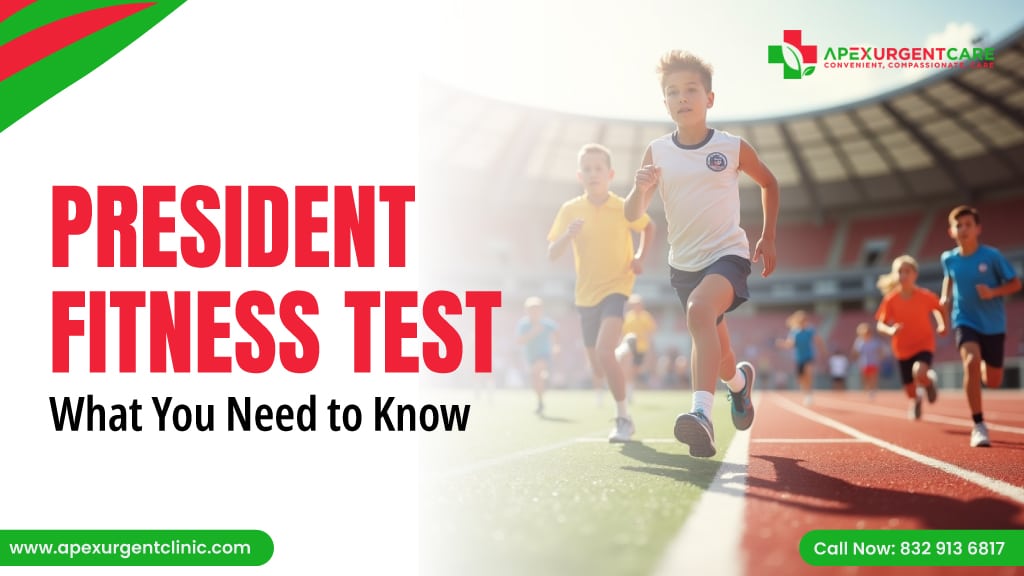
If you went to school before 2012, you probably remember the Presidential Fitness Test—the one-mile run that took forever, the sit-ups that made your abs burn, the push-ups or pull-ups that tested your upper-body strength, and the sit-and-reach flexibility challenge that revealed how far you could stretch. Well, guess what? It is making a comeback.
On July 31, 2025, former President Donald Trump signed an executive order reinstating this fitness program in U.S. public schools after more than a decade. A newly restructured President’s Council on Sports, Fitness, and Nutrition will oversee it, and a Presidential Fitness Award is set to roll out alongside.
Some see this as a powerful step toward improving youth health, while others worry that standardized testing could create stress or discourage kids who struggle with physical performance. At Apex Urgent Care Clinic, we believe the question is: How can parents and students prepare in a healthy, positive way without stress?
Should Parents Be Concerned About the Test?
If your child has an existing medical condition—such as asthma, a heart condition, or joint issues—it’s worth discussing it with our Houston doctor before they take the test. In some cases, modifications can be made. We regularly see families at our clinic for school physicals to ensure kids are fit for physical activity.
If your child needs a school physical or advice on safe training for the Presidential Fitness Test, visit Apex Urgent Care Clinic. Our Houstondoctor can help assess fitness levels, address health concerns, and guide you towards a healthy, confident test day.
What Is the Presidential Fitness Test?

The Presidential Fitness Test is a national fitness assessment designed to measure four key areas: cardiovascular endurance, muscular strength, core stability, and flexibility. Students will complete:
- A one-mile run to test endurance.
- Sit-ups for core strength.
- Push-ups or pull-ups for upper-body strength.
- A sit-and-reach flexibility challenge to check the range of motion.
While the structure is straightforward, the challenge is real for kids who have not been physically active in a while. That’s why preparation matters.
Why Bring It Back Now?
Supporters believe the program can help tackle childhood obesity, encourage healthy lifestyle habits, and reintroduce physical benchmarks for American students. Critics argue that not all kids thrive under performance-based testing, and some may feel excluded or embarrassed if they cannot meet the standard.
Our Houston doctor often reminds parents that fitness is personal, and while standardized tests can measure progress, they should never define a child’s overall health or worth. The goal is to encourage movement, not shame kids into it.
How Parents Can Support Their Kids
Here are some supportive ways you can help:
- Start Early: Instead of cramming workouts the week before, begin with light, regular activity—family walks, bike rides, or weekend hikes. This builds endurance gradually.
- Focus on Balance: Celebrate small improvements. Maybe your child can do more sit-ups than last month or shave a few seconds off their mile run. Progress counts.
- Nutrition Matters: A balanced diet with lean protein, fruits, vegetables, and whole grains helps fuel muscle strength and recovery. Hydration is as important, especially before endurance events.
How Schools Can Prepare Students Without Pressure
Teachers and coaches play a role in ensuring the Presidential Fitness Test feels like an opportunity rather than a punishment. That means:
- Building practice sessions into P.E. classes.
- Emphasizing personal bests over competition.
- Teaching stretching techniques to prevent injury.
At Apex Urgent Care Clinic, our Houston doctor has worked with student athletes who faced injuries from “pushing too hard too soon.” Warm-ups, proper form, and gradual improvement are key.
Conclusion: Make Fitness a Lifelong Habit
The Presidential Fitness Test is not about a score—it’s about building healthy habits early in life. If parents, schools, and healthcare providers work together, this program can inspire kids to stay active long after they leave the classroom.
Because in the end, it’s not about passing or failing—it’s about moving forward, one step, push-up, or sit-up at a time.

